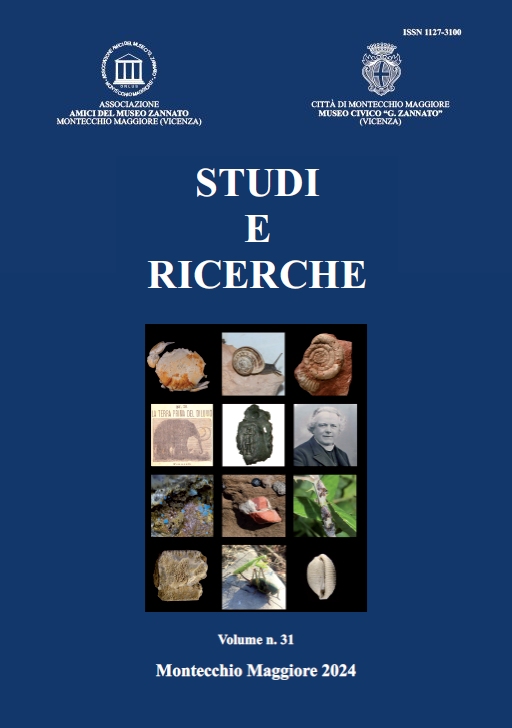Studi e Ricerche
Since 1994, the museum has published its own scientific journal, Studies and Research, as well as a number of monographs and articles of a naturalistic or archaeological nature.
The Editorial Board annually evaluates the publication of contributions of high scientific value. Unpublished works concerning topics within the field of natural sciences and archaeology are considered for publication, with preference given to those concerning the Veneto region and in particular the Vicenza area; a maximum of 2 articles per Author/Co-Author can be published.
The papers are first evaluated by the Editorial Board of the Journal, which submits them for peer review by external experts: articles that do not respect the relevance of the journal or are manifestly far from the quality standards of the Journal may be directly rejected by the Editorial Board. There is no cost to Authors for publication.
Database of the published articles
Here it is possible to search and browse all articles and papers published by the museum, using tags or search or by scrolling through the catalog by year of the full issues.
Battiston R; Caneva A
Il primo Yacaré storia naturale e culturale del rapporto tra uomini e caimani tra Nuovo e Vecchio Mondo Journal Article
In: Studi e Ricerche, vol. 29, pp. 35-42, 2022, ISSN: 1127-3100.
Abstract | Links | BibTeX | Tags: anthropology, conservation, crocodiles, education, history of science, iconographyn
@article{nokey,
title = {Il primo Yacaré storia naturale e culturale del rapporto tra uomini e caimani tra Nuovo e Vecchio Mondo},
author = {Roberto Battiston and Arianna Caneva},
editor = {Associazione Amici del Museo - Museo Civico “G. Zannato”},
url = {https://www.museozannato.it/wp-content/uploads/2023/07/Battiston-R-Caneva-A-2022-Il-Primo-Yacare-storia-naturale-e-culturale-del-rapporto-tra-uomini-e-caimani-tra-Nuovo-e-Vecchio-Mondo.pdf},
issn = {1127-3100},
year = {2022},
date = {2022-12-31},
urldate = {2022-12-31},
journal = {Studi e Ricerche},
volume = {29},
pages = {35-42},
abstract = {RIASSUNTO
Viene qui presentata un’analisi diacronica della raffigurazione dei caimani nel Nuovo Mondo e del rapporto di questi animali con le popolazioni locali. Viene proposta una visione d’insieme a partire dalle rappresentazioni mitologiche dell’epoca precolombiana passando per la cartografia cinquecentesca e i diari degli esploratori europei, le descrizioni scientifiche pre e post linneane fino alla situazione culturale e conservazionistica attuale, focalizzandosi sulle aree più meridionali di distribuzione di questi animali. Di particolare interesse risulta infatti il basso corso del fiume Paraná dove si ipotizzano nuovi scenari di incontro e scontro tra caimani in potenziale espansione e sprawl urbano delle aree metropolitane in forte crescita. Vengono identificate ed evidenziate le prime rappresentazioni note di questi animali nell’arte rupestre preistorica americana e la prima immagine non nativa di un yacaré, utili a comprendere l’evoluzione culturale del rapporto tra uomini e caimani. Viene infine valutato il ruolo dei musei e dell’educazione ambientale in questo contesto.
The First Yacaré: natural and cultural history of the relationship between humans and caimans between the Old and New World
ABSTRACT
A diachronic analysis of the depiction of the caimans in the New World and the relationship of these animals with local populations is presented here. An overview, starting from the mythological representations of the pre-Columbian era, passing through sixteenth-century cartography and the diaries of European explorers, pre- and post-Linnean scientific descriptions, up to the current cultural and conservational situation, is given, contextualized with the southernmost areas of distribution of these animals. In fact, of particular interest is the lower part of the Paranȧ River where new scenarios of confrontation between: the potential expansion of caimans and urban sprawl of fast-growing metropolitan areas, are hypothesized. The earliest known representations of these animals in prehistoric American rock art and the first non-native image of a yacaré are identified and evidenced in the understanding of the cultural evolution of the relationship between humans and caimans. Finally, the role of museums and environmental education is discussed in this context. },
keywords = {anthropology, conservation, crocodiles, education, history of science, iconographyn},
pubstate = {published},
tppubtype = {article}
}
Viene qui presentata un’analisi diacronica della raffigurazione dei caimani nel Nuovo Mondo e del rapporto di questi animali con le popolazioni locali. Viene proposta una visione d’insieme a partire dalle rappresentazioni mitologiche dell’epoca precolombiana passando per la cartografia cinquecentesca e i diari degli esploratori europei, le descrizioni scientifiche pre e post linneane fino alla situazione culturale e conservazionistica attuale, focalizzandosi sulle aree più meridionali di distribuzione di questi animali. Di particolare interesse risulta infatti il basso corso del fiume Paraná dove si ipotizzano nuovi scenari di incontro e scontro tra caimani in potenziale espansione e sprawl urbano delle aree metropolitane in forte crescita. Vengono identificate ed evidenziate le prime rappresentazioni note di questi animali nell’arte rupestre preistorica americana e la prima immagine non nativa di un yacaré, utili a comprendere l’evoluzione culturale del rapporto tra uomini e caimani. Viene infine valutato il ruolo dei musei e dell’educazione ambientale in questo contesto.
The First Yacaré: natural and cultural history of the relationship between humans and caimans between the Old and New World
ABSTRACT
A diachronic analysis of the depiction of the caimans in the New World and the relationship of these animals with local populations is presented here. An overview, starting from the mythological representations of the pre-Columbian era, passing through sixteenth-century cartography and the diaries of European explorers, pre- and post-Linnean scientific descriptions, up to the current cultural and conservational situation, is given, contextualized with the southernmost areas of distribution of these animals. In fact, of particular interest is the lower part of the Paranȧ River where new scenarios of confrontation between: the potential expansion of caimans and urban sprawl of fast-growing metropolitan areas, are hypothesized. The earliest known representations of these animals in prehistoric American rock art and the first non-native image of a yacaré are identified and evidenced in the understanding of the cultural evolution of the relationship between humans and caimans. Finally, the role of museums and environmental education is discussed in this context.
